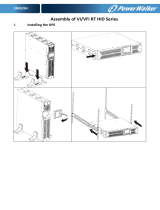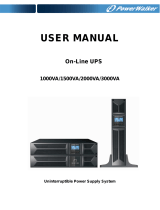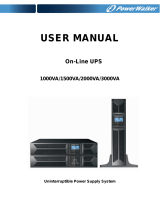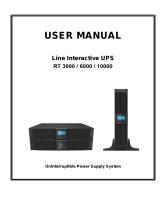Page is loading ...

6U Rack or Tower UPS
RT8.0kV A and RT1 1.0V A
and M ain tenan ce Bypa s s
Installation and User's Guide


6U Rack or Tower UPS
RT8.0kV A and RT11 .0V A
and M ain tenan ce Byp a s s
Installation and User's Guide

Note
Before using this information and the product it supports, read the general information in the Notices section; and
read the Safety Information and the Environmental Notices and User Guide on the Lenovo Documentation CD that came
with your product.
© Copyright Lenovo 2015.
LIMITED AND RESTRICTED RIGHTS NOTICE: If data or software is delivered pursuant a General Services
Administration “GSA” contract, use, reproduction, or disclosure is subject to restrictions set forth in Contract No.
GS-35F-05925.
© Lenovo 2015

Contents
Safety ...............v
Guidelines for trained service technicians ....vi
Inspecting for unsafe conditions ......vi
Guidelines for servicing electrical equipment . . vii
Safety statements ............viii
Product safety .............xiv
Chapter 1. Introduction ........1
Related documentation ...........1
Notices and statements ...........1
Environmental protection ..........2
Chapter 2. Presentation ........5
Standard installations ...........5
Rear panels ...............6
Control panel ..............7
LCD description .............8
Display functions .............9
User settings ..............10
Extended Battery Modules (EBMs).......14
HotSwap MBP .............15
Standard installations for the HotSwap MBP . . 15
HotSwap MBP controls .........15
Chapter 3. Installation ........17
Inspecting the equipment..........17
Unpacking the unit ............17
Checking the accessory kit: UPS .......18
Checking the accessory kit: HotSwap MBP ....19
Mechanical mounting ...........21
Connecting the EBM(s) ..........21
Rack installation .............21
Preparing the EBM for rack mounting ....21
Rack mounting of UPS, EBM, and accessory
modules ..............22
Tower installation ............23
Installing the communication card .......24
Installation requirements ..........25
Installation depending on the system earthing
arrangement (SEA) ............26
Chapter 4. Power cables connection . . 27
Access to terminal blocks ..........27
Common input sources connection (1Phase units) . 28
Common input sources connection (3Phase units) . 28
Separate input source connection (1Phase units) . . 29
Separate input source connection (3Phase units) . . 29
Frequency converter connection (1Phase units) . . 29
Frequency converter connection (3Phase units) . . 30
HotSwap MBP connection .........30
8/11k VA 1Phase ...........31
8/11k VA 3Phase with common Normal and
Bypass AC source ...........33
8/11k VA 3Phase with separate Normal and
Bypass AC source ...........34
Chapter 5. Operation.........37
UPS startup and shutdown .........37
Starting the UPS............37
Starting the UPS on Battery ........37
Shutting down the UPS .........38
UPS start-up with HotSwap MBP .......38
Monitoring the UPS operating mode ......39
Operating modes: descriptions .......39
Operating modes: summary ........40
Transferring the UPS between modes ......41
Setting High Efficiency mode ........41
Configuring Bypass settings .........41
Bypass transfer out of tolerance ......41
Interrupt time ............41
Configuring battery settings .........42
Retrieving the Event log ..........42
Retrieving the Fault log ..........42
Chapter 6. Communication ......43
Communication ports ...........43
Connecting RS232 or USB communication ports 43
Relay output contacts ..........43
Remote On/Off ............44
Remote Power Off ...........44
Connectivity card ...........45
Replacing the communication card ......46
UPS Power Management suite ........46
Chapter 7. UPS maintenance .....47
Equipment care .............47
Storing the equipment ...........47
Replacing battery packs ..........47
Replacing the internal battery pack .....48
Replacing the EBM(s) ..........50
Testing a new battery pack ........50
Replacing the UPS ............51
Removing the UPS ...........51
Returning to normal operation .......52
Recycling the used equipment ........53
Chapter 8. Troubleshooting ......55
Alarms and faults ............55
Silencing the alarm ............58
Service and support ...........58
Chapter 9. Parts listing ........59
Appendix A. Specifications ......61
UPS specifications ............61
HotSwap MBP specifications ........65
© Copyright Lenovo 2015 iii

Appendix B. Getting help .......69
Getting help and technical assistance ......69
Before you call ............69
Using the documentation .........70
Getting help and information from the World
WideWeb..............70
How to send DSA data .........70
Creating a personalized support web page . . . 71
Software service and support .......71
Hardware service and support .......71
Taiwan product service .........71
Appendix C. Notices .........73
Notices ................73
Trademarks .............74
Important notes ............74
Recycling information ..........75
Particulate contamination.........75
Telecommunication regulatory statement . . . 76
Electronic emission notices ........76
Appendix D. Glossary ........81
iv
Installation and User's Guide

Safety
Before installing this product, read the Safety Information.
Antes de instalar este produto, leia as Informações de Segurança.
Læs sikkerhedsforskrifterne, før du installerer dette produkt.
Lees voordat u dit product installeert eerst de veiligheidsvoorschriften.
Ennen kuin asennat tämän tuotteen, lue turvaohjeet kohdasta Safety Information.
Avant d'installer ce produit, lisez les consignes de sécurité.
Vor der Installation dieses Produkts die Sicherheitshinweise lesen.
Prima di installare questo prodotto, leggere le Informazioni sulla Sicurezza.
© Copyright Lenovo 2015 v

Les sikkerhetsinformasjonen (Safety Information) før du installerer dette produktet.
Antes de instalar este produto, leia as Informações sobre Segurança.
Antes de instalar este producto, lea la información de seguridad.
Läs säkerhetsinformationen innan du installerar den här produkten.
Guidelines for trained service technicians
This section contains information for trained service technicians.
Inspecting for unsafe conditions
Use this information to help you identify potential unsafe conditions in a Lenovo
product that you are working on.
Each Lenovo product, as it was designed and manufactured, has required safety
items to protect users and service technicians from injury. The information in this
section addresses only those items. Use good judgment to identify potential unsafe
conditions that might be caused by alterations or attachment of non- Lenovo
features or optional devices that are not addressed in this section. If you identify
an unsafe condition, you must determine how serious the hazard is and whether
you must correct the problem before you work on the product.
vi Installation and User's Guide

Consider the following conditions and the safety hazards that they present:
v Electrical hazards, especially primary power. Primary voltage on the frame can
cause serious or fatal electrical shock.
v Explosive hazards, such as a damaged CRT face or a bulging capacitor.
v Mechanical hazards, such as loose or missing hardware.
To inspect the product for potential unsafe conditions, complete the following
steps:
1. Make sure that the power is off and the power cords are disconnected.
2. Make sure that the exterior cover is not damaged, loose, or broken, and observe
any sharp edges.
3. Check the power cords:
v Make sure that the third-wire ground connector is in good condition. Use a
meter to measure third-wire ground continuity for 0.1 ohm or less between
the external ground pin and the frame ground.
v Make sure that the power cords are the correct type.
v Make sure that the insulation is not frayed or worn.
4. Remove the cover.
5. Check for any obvious non-Lenovo alterations. Use good judgment as to the
safety of any non-Lenovo alterations.
6. Check inside the system for any obvious unsafe conditions, such as metal
filings, contamination, water or other liquid, or signs of fire or smoke damage.
7. Check for worn, frayed, or pinched cables.
8. Make sure that the power-supply cover fasteners (screws or rivets) have not
been removed or tampered with.
Guidelines for servicing electrical equipment
Observe these guidelines when you service electrical equipment.
v Check the area for electrical hazards such as moist floors, nongrounded power
extension cords, and missing safety grounds.
v Use only approved tools and test equipment. Some hand tools have handles that
are covered with a soft material that does not provide insulation from live
electrical current.
v Regularly inspect and maintain your electrical hand tools for safe operational
condition. Do not use worn or broken tools or testers.
v Do not touch the reflective surface of a dental mirror to a live electrical circuit.
The surface is conductive and can cause personal injury or equipment damage if
it touches a live electrical circuit.
v Some rubber floor mats contain small conductive fibers to decrease electrostatic
discharge. Do not use this type of mat to protect yourself from electrical shock.
v Do not work alone under hazardous conditions or near equipment that has
hazardous voltages.
v Locate the emergency power-off (EPO) switch, disconnecting switch, or electrical
outlet so that you can turn off the power quickly in the event of an electrical
accident.
v Disconnect all power before you perform a mechanical inspection, work near
power supplies, or remove or install main units.
v Before you work on the equipment, disconnect the power cord. If you cannot
disconnect the power cord, have the customer power-off the wall box that
supplies power to the equipment and lock the wall box in the off position.
Safety vii

v Never assume that power has been disconnected from a circuit. Check it to
make sure that it has been disconnected.
v If you have to work on equipment that has exposed electrical circuits, observe
the following precautions:
– Make sure that another person who is familiar with the power-off controls is
near you and is available to turn off the power if necessary.
– When you work with powered-on electrical equipment, use only one hand.
Keep the other hand in your pocket or behind your back to avoid creating a
complete circuit that could cause an electrical shock.
– When you use a tester, set the controls correctly and use the approved probe
leads and accessories for that tester.
– Stand on a suitable rubber mat to insulate you from grounds such as metal
floor strips and equipment frames.
v Use extreme care when you measure high voltages.
v To ensure proper grounding of components such as power supplies, pumps,
blowers, fans, and motor generators, do not service these components outside of
their normal operating locations.
v If an electrical accident occurs, use caution, turn off the power, and send another
person to get medical aid.
Safety statements
These statements provide the caution and danger information that is used in this
documentation.
Important:
Each caution and danger statement in this documentation is labeled with a
number. This number is used to cross reference an English-language caution or
danger statement with translated versions of the caution or danger statement in
the Safety Information document.
For example, if a danger statement is labeled D005, translations for that caution
statement are in the Safety Information document under D005.
Be sure to read all caution and danger statements in this documentation before you
perform the procedures. Read any additional safety information that comes with
your system or optional device before you install the device.
viii Installation and User's Guide

L001
DANGER
Hazardous voltage, current, or energy levels are present inside any component
that has this label attached. Do not open any cover or barrier that contains
this label.
(L001)
Safety ix

D005
DANGER
When working on or around the system, observe the following precautions:
Electrical voltage and current from power, telephone, and communication
cables are hazardous. To avoid a shock hazard:
v If Lenovo supplied a power cord(s), connect power to this unit only with
the Lenovo-provided power cord. Do not use the Lenovo-provided power
cord for any other product.
v Do not open or service any power supply assembly.
v Do not connect or disconnect any cables or perform installation,
maintenance, or reconfiguration of this product during an electrical storm.
v The product might be equipped with multiple power cords. To remove all
hazardous voltages, disconnect all power cords.
v Connect all power cords to a properly wired and grounded electrical outlet.
Ensure that the outlet supplies proper voltage and phase rotation according
to the system rating plate.
v Connect any equipment that will be attached to this product to properly
wired outlets.
v When possible, use one hand only to connect or disconnect signal cables.
v Never turn on any equipment when there is evidence of fire, water, or
structural damage.
v Disconnect the attached power cords, telecommunications systems,
networks, and modems before you open the device covers, unless
instructed otherwise in the installation and configuration procedures.
v Connect and disconnect cables as described in the following procedures
when installing, moving, or opening covers on this product or attached
devices.
To disconnect:
1. Turn off everything (unless instructed otherwise).
2. Remove the power cords from the outlets.
3. Remove the signal cables from the connectors.
4. Remove all cables from the devices.
To connect:
1. Turn off everything (unless instructed otherwise).
2. Attach all cables to the devices.
3. Attach the signal cables to the connectors.
4. Attach the power cords to the outlets.
5. Turn on the devices.
v Sharp edges, corners and joints might be present in and around the system.
Use care when handling equipment to avoid cuts, scrapes and pinching.
(D005)
x Installation and User's Guide

C004
CAUTION:
Lead-acid batteries can present a risk of electrical burn from high, short-circuit
current. Avoid battery contact with metal materials; remove watches, rings, or
other metal objects, and use tools with insulated handles. To avoid possible
explosion, do not burn.
Exchange only with the Lenovo-approved part. Recycle or discard the battery as
instructed by local regulations. In the United States, Lenovo has a process for
the collection of this battery. For information, call 1-800-426-4333. Have the
Lenovo part number for the battery unit available when you call. (C004)
C009
CAUTION:
or or
The weight of this part or unit is between 18 and 32 kg (39.7 and 70.5 lb). It
takes two persons to safely lift this part or unit. (C009)
C011
CAUTION:
or
or
The weight of this part or unit is more than 55 kg (121.2 lb). It takes specially
trained persons, a lifting device, or both to safely lift this part or unit. (C011)
Safety xi

C022
CAUTION:
This product might be equipped with a hard-wired power cable. Ensure that a
licensed electrician performs the installation per the national electrical code.
(C022)
xii Installation and User's Guide

R001
Important: The following general safety information should be used for all
rack-mounted devices:
DANGER
Observe the following precautions when working on or around your IT rack
system:
v Heavy equipment—personal injury or equipment damage might result if
mishandled.
v Always lower the leveling pads on the rack cabinet.
v Always install stabilizer brackets on the rack cabinet.
v To avoid hazardous conditions due to uneven mechanical loading, always
install the heaviest devices in the bottom of the rack cabinet. Always install
servers and optional devices starting from the bottom of the rack cabinet.
v Rack-mounted devices are not to be used as shelves or work spaces. Do not
place objects on top of rack-mounted devices.
v Each rack cabinet might have more than one power cord. Be sure to
disconnect all power cords in the rack cabinet when directed to disconnect
power during servicing.
v Connect all devices installed in a rack cabinet to power devices installed in
the same rack cabinet. Do not plug a power cord from a device installed in
one rack cabinet into a power device installed in a different rack cabinet.
v An electrical outlet that is not correctly wired could place hazardous
voltage on the metal parts of the system or the devices that attach to the
system. It is the responsibility of the customer to ensure that the outlet is
correctly wired and grounded to prevent an electrical shock.
(R001 part 1 of 2)
Safety xiii

CAUTION:
v Do not install a unit in a rack where the internal rack ambient temperatures
will exceed the manufacturer’s recommended ambient temperature for all your
rack-mounted devices.
v Do not install a unit in a rack where the air flow is compromised. Ensure that
air flow is not blocked or reduced on any side, front, or back of a unit used
for air flow through the unit.
v Consideration should be given to the connection of the equipment to the
supply circuit so that overloading of the circuits does not compromise the
supply wiring or overcurrent protection. To provide the correct power
connection to a rack, refer to the rating labels located on the equipment in the
rack to determine the total power requirement of the supply circuit.
v (For sliding drawers) Do not pull out or install any drawer or feature if the rack
stabilizer brackets are not attached to the rack. Do not pull out more than one
drawer at a time. The rack might become unstable if you pull out more than
one drawer at a time.
v (For fixed drawers) This drawer is a fixed drawer and must not be moved for
servicing unless specified by the manufacturer. Attempting to move the
drawer partially or completely out of the rack might cause the rack to become
unstable or cause the drawer to fall out of the rack.
(R001 part 2 of 2)
Output power and ampere ratings
Important: Make sure that the power receptacle is near the equipment and is
easily accessible so that the uninterruptible power supply (UPS) can be
disconnected quickly.
To reduce the risk of fire, connect only to a circuit provided with branch circuit
overcurrent protection with an ampere rating in accordance with the National
Electrical Code (NEC), ANSI/NFPA 70 or your local electrical code:
UPS output power 120 V 208 V 230 V
1500 VA 15 A Not applicable 10 A
2200 VA 20 A Not applicable 10 A
3000 VA 30 A 20 A 16 A
Product safety
v The UPS connection instructions and operations described in the manual must
be followed in the indicated order.
v
Important: To reduce the risk of fire, the unit connects only to a circuit provided
with branch circuit overcurrent protection as described in this manual, in
accordance with the National Electric Code, ANSI/NFPA 70.
xiv Installation and User's Guide

The upstream circuit breaker for Normal AC and Bypass AC must be easily
accessible. The unit can be disconnected from AC power source by opening this
circuit breaker. This circuit breaker is used for backfeed protection and must
comply with IEC/EN 62040-1 (the creepage and clearance distances shall meet
the basic insulation requirements for pollution degree 2).
v Disconnection and overcurrent protection devices shall be provided by others for
permanently connected AC input (Normal AC and Bypass AC) and AC output
circuits.
v Check that the indications on the rating plate correspond to your AC powered
system and to the actual electrical consumption of all the equipment to be
connected to the system.
v For PLUGGABLE EQUIPMENT, the socket-outlet shall be installed near the
equipment and shall be easily accessible.
v Never install the system near liquids or in an excessively damp environment.
v Never let a foreign body penetrate inside the system.
v Never block the ventilation grates of the system.
v Never expose the system to direct sunlight or source of heat.
v If the system must be stored prior to installation, storage must be in a dry place.
v The admissible storage temperature range is -15ºC to +50ºC.
v This unit is not designed to conform to ANSI/NFPA 75 and therefore is not for
use in ANSI/NFPA 75-certified data centers.
v Although the UPS does not contain anti-backfeed (ABF) relays, some backfeed
protection is provided. For example, if some components are damaged in battery
mode, the output voltage may feed back to the input. In this case, a current
transformer (CT) is used to detect the bypass current feedback voltage. If a
current backfeed fault condition is detected, the UPS will terminate the inverter
output to avoid personal injury.
Safety xv

xvi Installation and User's Guide

Chapter 1. Introduction
Thank you for selecting a Lenovo product to protect your electrical equipment.
Read this manual to take full advantage of the features of your equipment.
Before installing your equipment, read the safety instructions. Then, follow the
instructions in this manual for setting up and using the product.
To discover the entire range of Lenovo products and the options available for the
Lenovo UPS device, we invite you to visit our website or contact your Lenovo
representative.
Related documentation
In addition to this document, the following documentation is available:
v Environmental Notices and User Guide
This document is provided on the Lenovo Documentation CD, and it contains
translated environmental notices.
v Safety Information
This document is provided on the Lenovo Documentation CD, and it contains
translated caution and danger statements. Each caution and danger statement
that appears in the documentation has a number that you can use to locate the
corresponding statement in your language in the Safety Information document.
v License Agreement for Machine Code
This document is provided on the Lenovo Documentation CD, and it contains the
translated license agreement for the product.
v Warranty Information
This multilingual document comes with the device, and it contains information
about the terms of the warranty.
Notices and statements
The caution and danger statements in this document are also in the multilingual
Safety Information document, which is on the Lenovo Documentation CD. Each
statement is numbered for reference to the corresponding statement in the Safety
Information document.
Notices and statements in this document
The following notices and statements are used in this document:
v Note: These notices provide important tips, guidance, or advice.
v Important: These notices provide information or advice that might help you
avoid inconvenient or problem situations.
v Attention: These notices indicate possible damage to programs, devices, or data.
An attention notice is placed just before the instruction or situation in which
damage might occur.
v Caution: These statements indicate situations that can be potentially hazardous
to you. A caution statement is placed just before the description of a potentially
hazardous procedure step or situation.
© Copyright Lenovo 2015 1

v Danger: These statements indicate situations that can be potentially lethal or
hazardous to you. A danger statement is placed just before the description of a
potentially lethal or hazardous procedure step or situation.
Environmental protection
Lenovo has implemented an environmental-protection policy. Products are
developed according to an eco-design approach.
Substances
This product does not contain CFCs, HCFCs or asbestos.
Packing
To improve waste treatment and facilitate recycling, separate the various packing
components.
v The cardboard we use comprises over 50% of recycled cardboard.
v Sacks and bags are made of polyethylene.
v Packing materials are recyclable and bear the appropriate identification symbol
.
Materials Abbreviations
Number in the symbols
Polyethylene terephthalat PET 01
High-density polyethylene HDPE 02
Polyvinyl chloride PVC 03
Low-density polyethylene LDPE 04
Polypropylene PP 05
Polystyrene PS 06
Follow all local regulations for the disposal of packing materials.
Refer to the Lenovo Environmental Notices and User's Guide, provided on the
documentation CD.
End of life
Lenovo will process products at the end of their service life in compliance with
local regulations. Lenovo works with companies in charge of collecting and
eliminating our products at the end of their service life.
Product
The product is made up of recyclable materials. Dismantling and destruction must
take place in compliance with all local regulations concerning waste. At the end of
its service life, the product must be transported to a processing center for electrical
and electronic waste.
2 Installation and User's Guide
/



